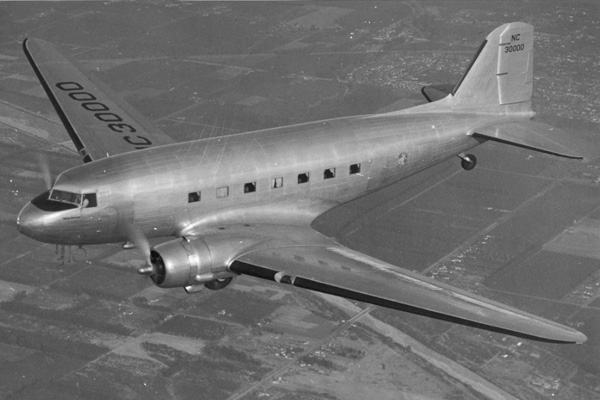The disappearance of the Douglas DC-3 airliner NC16002 occurred on the night of December 28, 1948 near the end of a scheduled flight from San Juan, Puerto Rico to Miami, Florida (around 1,030 mi (1,660 km)). The aircraft carried 29 passengers and three crew members. No probable cause for the loss was determined by the official investigation and it remains unsolved.
Final flight
Captained by pilot Robert Linquist, assisted by co-pilot Ernest Hill and stewardess Mary Burkes, the aircraft ended its Miami-San Juan leg at 19:40 EST on 27 December. Linquist informed local repair crewmen that a landing gear warning light was not functioning and that the aircraft batteries were discharged and low on water. Unwilling to delay the aircraft's scheduled takeoff for Miami for several hours, Linquist said the batteries would be recharged by the aircraft’s generators en route.Linquist taxied NC16002 to the end of runway 27 for takeoff, but stopped at the end of the tarmac due to lack of two-way radio communication. Though capable of receiving, Linquist reported to the head of Puerto Rican Transport, who had driven out to the aircraft, that the radio could not transmit because of the low batteries. After agreeing to stay close to San Juan until they were recharged enough to allow two-way contact, NC16002 finally lifted off at 22:03. After circling the city for 11 minutes, Linquist received confirmation from CAA at San Juan and told the tower that they were proceeding to Miami on a previous flight plan.
The weather was fine with high visibility, but the aircraft did not respond to subsequent calls from San Juan. At 23:23, the Overseas Foreign Air Route Traffic Control Center at Miami heard a routine transmission from NC16002, wherein Linquist reported they were at 8,300 ft (2,500 m) and had an ETA of 04:03. His message placed the flight about 700 mi (1,100 km) from Miami. Transmissions were heard sporadically throughout the night by Miami, but all were routine.
At 03:40, Linquist reported he was 50 mi (80 km) south of Miami. The transmission was not heard at Miami but was monitored at New Orleans, Louisiana, some 600 mi (970 km) away, and was relayed to Miami. The accident investigation report issued by the Civil Aeronautics Board said the pilot may have incorrectly reported his position.
Miami weather was clear but the wind had moved from northwest to northeast. The accident investigation report said Miami transmitted the wind change information but neither Miami nor New Orleans "was able to contact the flight" so it is unknown whether NC16002 received it. Without this knowledge the aircraft could have drifted 40–50 mi (64–80 km) off course, which widened the search area to include hills in Cuba, the Everglades and even Gulf Of Mexico waters.
Nothing further was heard from Linquist and the aircraft has never been found. In subsequent years, researchers into unexplained disappearances have included the flight among others said to have disappeared in what came to be termed the Bermuda Triangle.
Investigation
In a report released July 15, 1949, the board convening the investigation filed several factors about the aircraft:- The aircraft originally built on June 12, 1936, and had a total of 28,257 flying hours prior to the landing in San Juan. It was inspected several times in the past two years and certified to be airworthy.
- The aircraft was given a partial overhaul, including the replacement of both engines in November 1948. An in-flight test was conducted to judge the results of the overhaul, including flying to New Jersey and back. Again, the aircraft was certified to be airworthy.
- The company's maintenance records were incomplete. In one case a subcontractor working on an engine in October 1948 completed the task but did not save any records proving it.
- Captain Linquist told San Juan that his landing gear down indicator lamps did not work. This led to the discovery that his batteries were low on water and electrical charge. While he ordered the refilling of the batteries with water, he ordered the reinstallation of the batteries onboard the aircraft without recharging them.
- The aircraft left with the batteries charged only enough to satisfy two-way radio communication with the tower, with the understanding an in-flight flight plan would be filed before they left the vicinity of San Juan. This was not done, and the plane continued on a course for Miami. It was noted in the report that the plane's radio transmitter did not function properly due to the low battery charge.
- The aircraft left San Juan with a cargo/passenger weight 118 lb (54 kg) over the allowable limit.
- A message was sent to the plane concerning a change in wind direction which could have been strong enough to push the plane off course. It was not known if the plane received the message.
- The plane's electrical system was not functioning normally prior to departing San Juan.
| Occurrence summary | |
|---|---|
| Date | December 28, 1948 |
| Type | Unexplained disappearance |
| Site | Off the eastern coast of Florida |
| Passengers | 29 |
| Crew | 3 |
| Injuries | 0 |
| Fatalities | 32 (missing) |
| Survivors | 0 |
| Aircraft type | Douglas DC-3DST-144 |
| Operator | Airborne Transport |
| Tail number | NC16002 |
| Flight origin | San Juan, Puerto Rico |
| Destination | Miami, Florida |







0 comments:
Post a Comment